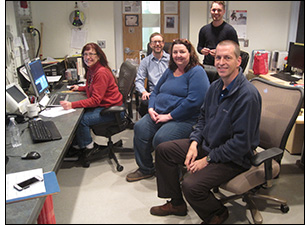Recent News
December 5 Seminar: Sal Portillo
December 3, 2025
November 21 Seminar: Jim Aarestad
November 19, 2025
November 14 seminar: Manel Martínez-Ramón
November 12, 2025
November 7 seminar: Bradley Ratliff
November 5, 2025
News Archives
Vince Calhoun Scores: PNAS Paper is a Hit!
December 1, 2014 - Chuck Reuben
 Newspapers and TV reporters often tell us stories about new scientific triumphs: cures for cancer, the launching of spaceships and the development of new energy sources. But rarely does a scientific paper itself become the center of attention.
Newspapers and TV reporters often tell us stories about new scientific triumphs: cures for cancer, the launching of spaceships and the development of new energy sources. But rarely does a scientific paper itself become the center of attention.
Despite this, ECE distinguished professor Vince Calhoun recently became the focus of local and national news after co-authoring an 8,000 word paper that appeared in the Nov. 12 edition of the Proceedings of the National Academy of Sciences (PNAS). Calhoun’s paper can be found here
PNAS was created in 1914 and is one of the world’s most-cited and comprehensive multidisciplinary scientific journals. It is a scholarly publication that raises the eyebrows of researchers and scientists but not many others. The paper that Calhoun co-authored was entitled “Long term effects of marijuana use on the brain.”
“This is probably the largest multimodal brain imaging study of marijuana to date,” said Calhoun in a recent interview. “[The paper is] significant in that it shows the changes between cannabis users and controls across multiple types of brain imaging.”
 It seems that Calhoun was in the right place at the right time. New Mexicans had just returned from voting in their mid-term elections and were processing the results of a referendum that asked them whether they wanted to decriminalize the use of marijuana.
It seems that Calhoun was in the right place at the right time. New Mexicans had just returned from voting in their mid-term elections and were processing the results of a referendum that asked them whether they wanted to decriminalize the use of marijuana.
The results of this November 8th election were decisive. Bernalillo County voted in favor of decriminalization 60 to 40 percent. In Santa Fe, the results were 73 percent to 26 percent in favor of decriminalization.
So it seems there was broad interest in the topic of marijuana in New Mexico and beyond when Calhoun’s paper was finally published by PNAS after months of intense peer review. The results in the study show difference in the brain in marijuana users compared to non-users, which in turn fostered much discussion.
The attention received by Calhoun’s paper was impressive:
On Nov. 10, 2014, two days before the story was released on the internet, ScienceDaily wrote a story that elegantly encapsulated the essence of the paper. It can be found here
 On Nov. 11, one day before the paper was officially released on the internet, CNN published a story based on the paper in their health section. Click here to read the story.
On Nov. 11, one day before the paper was officially released on the internet, CNN published a story based on the paper in their health section. Click here to read the story.
On that same day, CBS also featured the story and it can be found here.
On Nov. 12, the same day that the paper was officially released, The Albuquerque Journal published a story based on that paper entitled, “Study: Heavy pot smoking shrinks gray matter”
And on Nov. 24, The Daily Lobo, the independent newspaper at the University of New Mexico, joined the pack by publishing the following story,
“I myself have a hard time understanding the study . . ." said J.R. Oppenheim, managing editor of The Daily Lobo.
“I can tell you,” Oppenheim continued, “[that] a key component of a newspaper journalists' job is to take difficult information and present it in a way to make it understandable to as many people as possible.”
“A journalist needs to strike that balance between jargon and laymen terminology in order to provide readers with the key information. It's not easy, but it's essential,” said Oppenheim.
 Despite the fact that very few laymen actually read Calhoun’s paper, his message appeared to get around the country, if not the planet, thanks to a handful of dedicated journalists who captured the story in Calhoun’s study at a level that most of us can understand.
Despite the fact that very few laymen actually read Calhoun’s paper, his message appeared to get around the country, if not the planet, thanks to a handful of dedicated journalists who captured the story in Calhoun’s study at a level that most of us can understand.
When Calhoun was asked about the success of the paper, he modestly replied that there was “lots of interest. Much of it is hitting the first author primarily. No paparazzi though, thankfully. I suspect it will fade out like everything does, until the next paper.” The lead author, Francesca M. Filbey designed the study and received the funding. Calhoun was primarily involved in helping set up the scanning and performing the analysis.
And it would appear that there is another paper forthcoming. He said that his group is now “looking at other variables to see if those are related to cannabis use, looking at doing brain scans in the same person before and after use, and studying other data, for example, brain imaging collected from children whose mother smoked pot.”
Vince Calhoun speaks candidly here about the subject matter of a paper that challenged so many members of the media:
